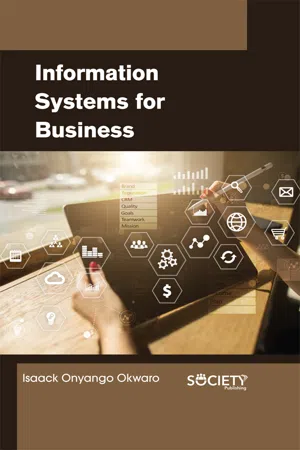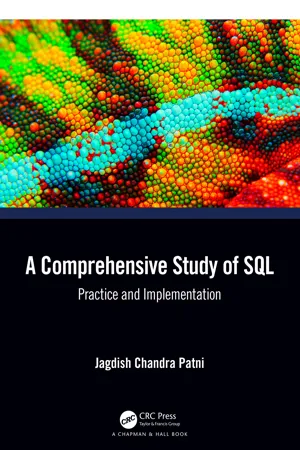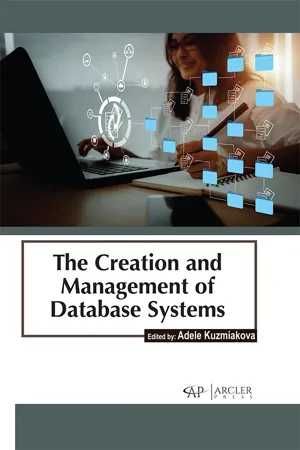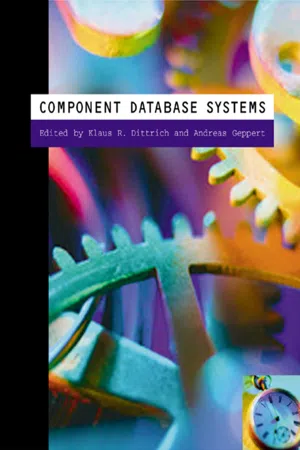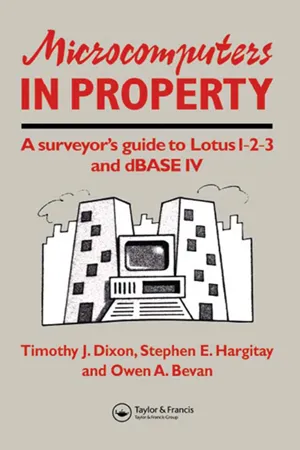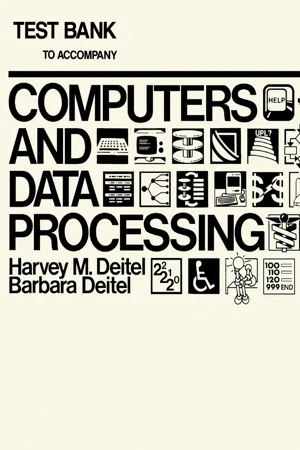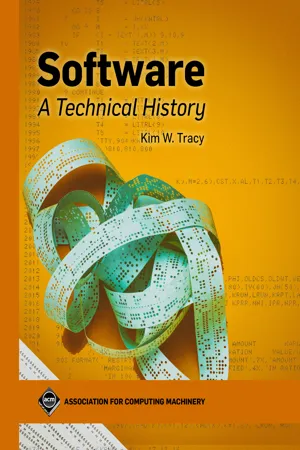Computer Science
Database Management System
A Database Management System (DBMS) is a software that allows users to create, retrieve, update, and manage data in a database. It provides an interface for users to interact with the database, and handles tasks such as data storage, retrieval, and security. DBMSs are essential for organizing and maintaining large volumes of data efficiently.
Written by Perlego with AI-assistance
Related key terms
1 of 5
10 Key excerpts on "Database Management System"
- eBook - PDF
- Isaack Onyango Okwaro(Author)
- 2019(Publication Date)
- Society Publishing(Publisher)
Database Management System 4 LEARNING OBJECTIVES: After reading this chapter, you would be able to: • The concept of Database Management System (DBMS). • The importance and impact of having a DBMS in business processes. • Management of Risk through DBMS. • Different aspects of operations management. CHAPTER • Analysis • Data independence • Database • Decision-making • File-based system • Flexibility • Integration • Knowledge • Sharing KEYWORDS Information Systems for Business 68 4.1. INTRODUCTION A Database Management System (DBMS) is a collection of programs that enables you to store, modify, and extract information from a database. The DBMS provides the users and programmers with a systematic way to create, retrieve, update, and manage data. This is a collection of related data with an implicit meaning and hence is a database . A DBMS makes it possible for end users to create, read, update, and delete (CRUD) data in a database. The DBMS accepts the request for data from an application and instructs the operating system to provide the specific data. In large systems, a DBMS helps users and other third-party software to store and retrieve data. By data, we mean known facts that can be recorded and that have implicit meaning. For example, you want to record the details of people you know, such as their names, addresses, and telephone numbers (Figure 4.1). Figure 4.1: Database Management System (DBMS). Source: http://www.thebluediamondgallery.com/tablet/images/data-base.jpg For this, you can either record the details in an address book or a diskette, or you may store the data using your personal; computer/ Database Management System 69 Database is an organized collection of data, generally stored and accessed electronically from a computer system. laptop and software such as DBASE IV or V, Microsoft Access or Excel. A datum – a unit of data – is a symbol or a set of symbols which is used to represent something. - eBook - ePub
A Comprehensive Study of SQL
Practice and Implementation
- Jagdish Chandra Patni(Author)
- 2022(Publication Date)
- CRC Press(Publisher)
1 Database SystemsDOI: 10.1201/9781003324690-1A database is a well-defined collection of structured information, or data, which is typically stored digitally in a computer system. The control unit that usually controls the database is known as the Database Management System (DBMS). The data and the DBMS, along with the applications that are related to them, are referred to as a database system, often abbreviated as just a database. The database is a collection of interrelated data that is used to effortlessly retrieve, manipulate, insert and delete the data. It is also used to organize the data in the form of a table including rows and columns, schema, views, reports, etc.The most common type of data within various databases in operation today is typically patterned in rows and columns in a series of tables to make processing and data manipulation efficient and easy. Further, this data can be easily organized, accessed, managed, modified, updated, and controlled. Most databases use structured query language (SQL) to write and manipulate the data. SQL is a programming language that is used by nearly all relational databases to manipulate, define data, query data, and provide access control.A database typically requires an extensive database software program known as a DBMS. A DBMS serves as an interface between the database and its end users or programs that help the user retrieve, update, and manage how the information is organized and optimized. A DBMS also facilitates error control of databases, enabling various administrative operations, such as performance monitoring, tuning, and backup and recovery of the data.Some examples of popular database software or DBMSs include MySQL, Microsoft SQL Server, Microsoft Access, Oracle Database, FileMaker Pro and dBASE.1.1 Introduction to Databases
Databases have evolved dramatically since their beginning in the early 1960s. Navigational databases, such as the hierarchical database (which was in the form of a tree-like model and allowed only a one-to-many relationship) and the network database (a more flexible model that allowed multiple relationships), were the original models used to store and manipulate data. These early systems were simple to understand, but they were inflexible. In the 1980s, relational databases became popular, followed by another type of database that is object-oriented databases in the 1990s. Nowadays, NoSQL databases are in demand as the growth of the internet and the need for faster speed and processing of unstructured data have increased. Today, cloud and self-driving databases are setting up new records regarding how data is collected, stored, managed, manipulated, and utilized. - Mark L. Gillenson, Paulraj Ponniah, Alex Kriegel, Boris M. Trukhnov, Allen G. Taylor, Gavin Powell, Frank Miller(Authors)
- 2012(Publication Date)
- Wiley(Publisher)
Keep in mind throughout this chapter that databases and DBMSs have different roles and different components. The database, while a complicated entity in itself, at its core is simply where we store the data. The DBMS contains all of the other components that make the database a viable storage and retrieval tool. 2.1 Introduction to Key Database Concepts Today, almost all organizations depend on their database systems for the crucial information they need to run their business. In every industry, from the small mom and pop business to multinational enterprises and government agencies, database systems are the norm for information storage and retrieval. Commerce, whether traditional brick and mortar or Internet-based e-commerce, thrive or die based on how they use the data they collect. Database and Web technologies have merged into something significantly more powerful than either one alone. The Information Technology (IT) department of today’s organization has the primary responsibility for designing, supporting, and maintaining database sys- tems. However, IT personnel aren’t the only ones who need at least some under- standing of database technologies and what they can do for a business. Data, in today’s rapidly changing environment, is everybody’s business. 2.1.1 Database Approach to Data As you learned in Chapter 1, a database can be defined as an ordered collection of related data elements intended to meet the information needs of an organi- zation and designed to be shared by multiple users, as described in Figure 2-1. Let’s break the characteristics of a database down: ▲ A database is an ordered collection. It is a collection of data elements— not a random group, but a collection put together deliberately, with proper order. The data elements are linked together in the most logical manner. 26 INTRODUCING DATABASES AND Database Management SystemS ▲ A database contains related data elements.- Adele Kuzmiakova(Author)
- 2023(Publication Date)
- Arcler Press(Publisher)
1.4.1. Role and Advantages of the DBMS The DBMS acts a link between the operator besides the server. Every data model is kept as a set of files, with the DBMS being the sole mechanism to retrieve the data within these file systems. The DBMS provides the conclusion customer (or software applications) with a unified, combined model of the statistics stored in the database, as shown in Figure 1.2. All program requirements remain conventional through the DBMS, which before converts them hooked on the complex procedures essential to fulfill them. The folder organization system (DBMS) conceals an amount of the record’s fundamental difficulty after requests and operators. The software application could be developed by a developer in a computer language like Visual Studio, Java, or C#, or it could be generated by a DBMS software developed (Sigmund, 2006). Figure 1.2. The Database Management System (DBMS) controls the interface between the end-user then the database. Source: https://slideplayer.com/slide/14646685/. The Creation and Management of Database Systems 8 The employment of a DBMS among both the employer’s programs and also the file has many benefits. The DBMS, for starters, allows the database’s contents to also be shared across various applications and customers. Second, the DBMS combines the many distinct users’ perspectives on information hooked on a solitary, all-inclusive statistics source (Hübner, 2016). While statistics is the most important rare physical out of which data remains provided, you’ll need a strong data management system. The DBMS, as you’ll see in this book, makes data administration more efficient and productive. A DBMS, for instance, offers benefits such as (LaFree & Dugan, 2007): • Data Exchange has Been Improved: The database server (DBMSs) facilitates the construction of an ecosystem wherein programs have much more efficient access to information.- eBook - PDF
- Klaus R. Dittrich, Andreas Geppert(Authors)
- 2000(Publication Date)
- Morgan Kaufmann(Publisher)
1 Component Database Systems: Introduction, Foundations, and Overview Andreas Geppert Klaus R. Dittrich University of Zurich • • • • • • • • • • • • • • • • • • • • • • • • • • • • • • • • • • • • • • • • • • • • • • • • • • • • • • • • • • • • • • • • • • • • • • • • • • • • • • • • • • • • 1.1 Introduction Database Management Systems (DBMSs) support individual applica-tions and comprehensive information systems with modeling and long-term reliable data storage capabilities as well as with retrieval and manipulation facilities for persistent data by multiple concurrent users or transactions. The concept of data model (most notably the relational models, Codd 1970; and the object-oriented data models, Atkinson et al. 1989; Cattell & Barry 1997), the Structured Query Language (SQL, Melton & Simon 1996), and the concept of transaction (Gray & Reuter 1992) are crucial ingredients of successful data management in current enterprises. Nowadays DBMSs are well established and are, indeed, the cornerstones of virtually every enterprise. Traditionally, data elements stored in databases have been simply structured (e.g., employee records, and product and stock informa-tion). Transactions have been of short duration and often needed to access only a few data items. Most traditional queries have been simple and the techniques used to answer them efficiently are well under-stood. Taking a broader view, DBMS-based information systems have been built in a rather database-centric way; that is, environment deci-sions such as the use of mainframe-based or client/server architectures have been typically based on what the DBMS itself requires or supports in this respect. In the recent past, however, more and more new and demanding application domains have emerged that could also benefit from data-base technology, and new requirements have been posed to DBMSs. Many applications require the management of data types that are not handled well by conventional DBMSs. - eBook - PDF
Technology for Success
Computer Concepts
- Cengage, Jennifer Campbell, Mark Ciampa, Barbara Clemens, Steven Freund(Authors)
- 2019(Publication Date)
- Cengage Learning EMEA(Publisher)
Module 13: Databases CC 13-25 13 MODULE Summary A database is a collection of data organized in a manner that allows access, retrieval, and report- ing of that data. Data is the lifeblood of most organizations, and databases are entrusted with the critical job of organizing this data, making it easily accessible when needed, and ensuring the data is kept safe and secure. Unlike a spreadsheet, a database can show relationships between tables. A relationship shows how data in one table relates to data in another table. However, the many advan- tages of databases come at a cost; databases are complicated to design and set up, requiring intricate knowledge of the data in order to structure it appropriately. Relational databases rely on relationships between types of data to show how some data is related to other data. Relational databases are best suited to data that can be organized into tables where each record in a table stores the same pieces of information. Most relational databases are managed using Structured Query Language (SQL). The data in a database is accessed through a Database Management System (DBMS), which is a collection of programs used to interact with and manage data in the database. One common example of a DBMS is Microsoft Access. Others include Oracle Database and MySQL. When you interact with your social media account on a website, you’re using the front-end database user interface that is built using web languages such as HTML, CSS, and JavaScript. Database designers and administrators interact with the database’s back-end, which includes the database server host- ing the data, some aspects of the DBMS, and the database itself. Microsoft Access includes both front-end and back-end elements. Data in a database is organized to allow for quick searches and to support connections between data in relationships. - eBook - ePub
Microcomputers in Property
A surveyor's guide to Lotus 1-2-3 and dBASE IV
- O. Bevan, T.J. Dixon, S. Hargitay(Authors)
- 2014(Publication Date)
- Taylor & Francis(Publisher)
6 Database Management Systems 6.1 Introduction 6.2 What is a DBMS? 6.3 Types of DBMS 6.4 How does a DBMS work? 6.5 What to look for in a DBMS 6.6 dBASE IV – a family of releases 6.7 dBASE IV – how does it work? 6.8 What can a DBMS be used for? Objectives After reading this chapter you should be able to:- Define the terms ‘data management’ and ‘Database Management System’ (DBMS);
- Distinguish between the four main types of DBMS;
- Define the terms ‘field’, ‘record,’ ‘file’ and ‘database’;
- recognize the basic features and explain the main functions in a DBMS;
- Choose the right DBMS for your business;
- List the main features of dBASE IV;
- Recognize the minimum system requirements for dBASE IV;
- Describe the simple operations that may be carried out on dBASE IV;
- List the estate management tasks which are most suitable for DBMS.
As far as surveying and estate management are concerned, a Database Management System (DBMS) is one of the most important types of software a surveyor or valuer can use. These packages have been around a number of years now, although originally they were designed with a mainframe use in mind. These days, though, they are able to run on micros very easily, and they offer the surveyor the opportunity to set up what are essentially computerized filing systems. Most of use have at one time or another used a manual filing system, and probably spent a very long time trying to find the data we wanted. A computer can sort through countless data much more quickly and accurately than we can.Despite the inherent simplicity of DBMS - eBook - PDF
- Mark L. Gillenson(Author)
- 2012(Publication Date)
- Wiley(Publisher)
Clearly this example 48 Chapter 3 The Database Management System Concept calls for direct access. In fact, the vast majority of information systems operations that all companies perform today require direct access. Both sequential access and direct access can certainly be accomplished with data stored in simple files. But simple files leave a lot to be desired. What is the concept of database and what are its advantages? THE DATABASE CONCEPT The database concept is one of the most powerful, enduring technologies in the information systems environment. It encompasses a variety of technical and managerial issues and features that are at the heart of today’s information systems scene. In order to get started and begin to develop the deep understanding of database that we seek, we will focus on five issues that establish a set of basic principles of the database concept: 1. The creation of a datacentric environment in which a company’s data can truly be thought of as a significant corporate resource. A key feature of this environment is the ability to share data among those inside and outside of the company who require access to it. 2. The ability to achieve data integration while at the same time storing data in a non-redundant fashion. This, alone, is the central, defining feature of the database approach. 3. The ability to store data representing entities involved in multiple relationships without introducing data redundancy or other structural problems. 4. The establishment of an environment that manages certain data control issues, such as data security, backup and recovery, and concurrency control. 5. The establishment of an environment that permits a high degree of data independence. Data as a Manageable Resource Broadly speaking, the information systems environment consists of several components including hardware, networks, applications software, systems software, people, and data. The relative degree of focus placed on each of these has varied over time. - Harvey M. Deitel, Barbara Deitel(Authors)
- 2014(Publication Date)
- Academic Press(Publisher)
( Τ p296) Fill-in-the-Blanks 107. MIS is generally used in ad hoc Inquiring and reporting. ( F p296) VisiCalc 108. VisiCalc is en excellent example of a what-if DSS system. (Τ p298) 109. VisiCalc is en electronic worksheet system. ( Τ p298) Test Bank Chapter 11: DBMS, MIS, DSS 264 Data as a Business Resource !. A database is ordinarily a large collection of related data items. 2. The process of keeping files correct, complete, and up-to-date is called file maintenance . 3. When the same data appears in several files we have what is called redundancy . 4. Redundancy is a useful security measure, but it is costly and could result in the use of out-of-date information. Database Management Systems 5. When a user program inquires If a particular item Is in the database, a Database Management System (DBMS) does the actual searching and retrieving. 6. The DBMS creates the database, keeps it up-to-date, and provides access to authorized users. 7. A DBMS ensures that what is supposed to be in the database is there, and what is not supposed to be there isn't; this is called database integrity . 8. Τ he per son who deter mines who may access the database, modify it, and add new relationships is the database administrator . Hierarchical Database 9. In a hierarchical database, data records are arranged in a strict parent/child (boss/employee) relationship. 10. Searching a hierarchical database is rapid and convenient as long as it is searched from the top down. Network Database 11. The network database Is a more general structure than the hierarchical database; it can answer a wide variety of questions without having to provide duplicate data or to reorganize the database. 12. A network database uses pointers , special data Items inside the computer that correspond to arrows in the diagram. Test Bank Chapter 11: DBMS, MIS, DSS 265 Relational Database 13. In a relational database, information is stored as tables. 14. The tables in a relational database are called relations .- eBook - PDF
Software
A Technical History
- Kim W. Tracy(Author)
- 2021(Publication Date)
- ACM Books(Publisher)
7 by many applications that were being built. With the advent of more online stor- age such as IBM’s 305 RAMAC 1 system in 1956 (see Figure 7.1), systems that relied on data became more feasible. By the 1960s, ways to efficiently store, change, and report on data took the form of file systems that evolved into what became known as Database Management Systems (DBMSs). These DBMSs took several dif- ferent architectural approaches that will be discussed in this chapter. By the 1980s, the relational approach began to take hold, and by the 1990s, became the most common database architecture. The amount of online file storage available to systems has increased at an incredible pace since the first online systems. Online files are those that can be immediately referenced and used without human intervention. In the early 1960s, systems able to access files of thousands of millions of bits (gigabits or 100s of megabytes) were considered very large [Martin 1977, p. 3]. By the early 1970s, the largest systems were able to access files of hundreds of thousands of millions of bits (100s of gigabits or 10s of gigabytes). By the early 1980s, larger systems were able to access tens of millions of millions of bits (10s of terabits or terabytes). This expo- nential growth trend of increased online file capacity has continued to increase by a factor of about 100 every decade, with systems in the 2010s exceeding hun- dreds of terabytes and moving well into petabyte and exabyte territory. Databases Database Management Systems The management of data is key to the development of any modern, large-scale system. But that wasn’t always the case during the history of computing as early computers focused on numerical problem solving and didn’t have direct access to a lot of online data. As computer systems became larger and more widely avail- able, it was clear that a reliable way to store, change, and report on data was needed 1.
Index pages curate the most relevant extracts from our library of academic textbooks. They’ve been created using an in-house natural language model (NLM), each adding context and meaning to key research topics.
